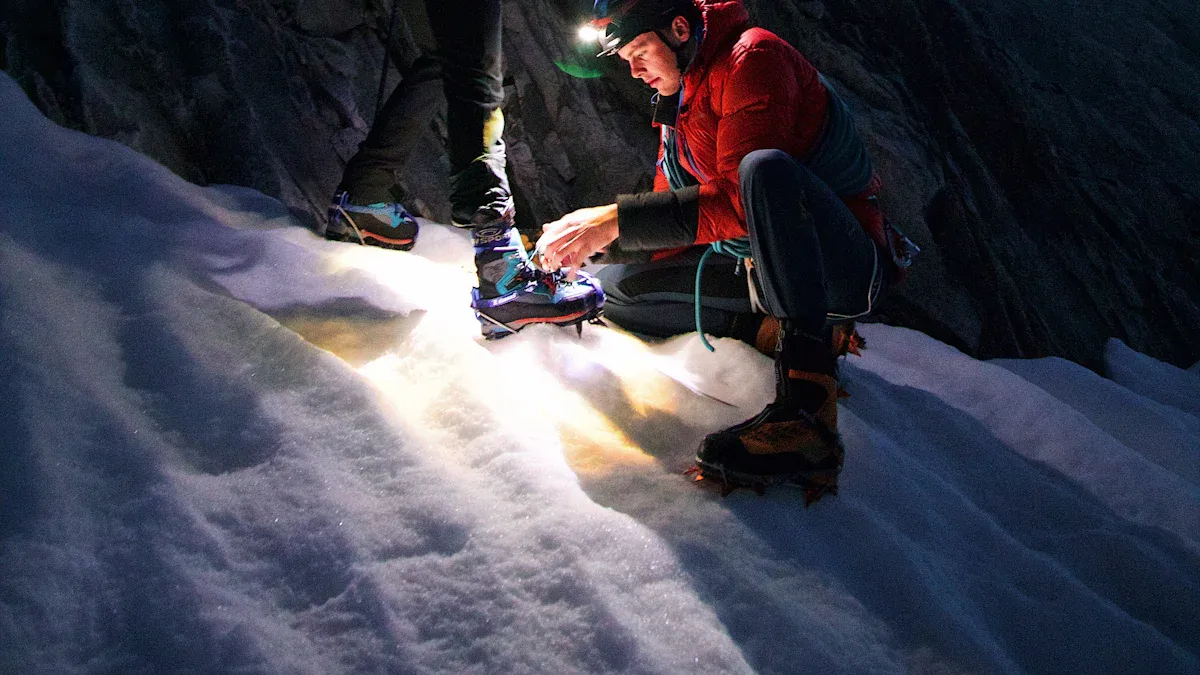How to Choose a Headlamp for Nighttime Hiking and Outdoor Activities

When you're out on a nighttime hiking adventure, a reliable headlamp can make all the difference. It keeps your hands free while lighting up the path ahead. A low-quality headlamp, though, can lead to trouble. Poor visibility might cause you to miss uneven terrain or trip over obstacles. Choosing the right one ensures you stay safe and enjoy the journey. Whether you're exploring trails or setting up camp, a good headlamp is your best companion. Some even prefer the helius flashlight for its versatility, but a headlamp offers unmatched convenience.
Key Takeaways
Pick a headlamp that suits your activity. For close-up tasks, choose 50-150 lumens. For hiking, go for 150-300 lumens. For running at night, pick 300+ lumens.
Think about battery life. Rechargeable batteries work well for short trips. For longer trips, use disposable batteries or hybrids for more options.
Make sure it fits comfortably. A light headlamp with an adjustable strap stays secure. This makes outdoor activities more enjoyable.
Understanding How to Choose Headlamps for Your Needs
Activities and Environments
Choosing the right backpacking headlamp depends on what you’ll be doing and where. Different outdoor activities require specific features. For example:
Close-up tasks like cooking or reading need 50-150 lumens and a flood beam for wide, even lighting.
Hiking or moderate activities benefit from 150-300 lumens with a flood/spot beam combination.
Night running or long-distance visibility demands 300+ lumens and a spot beam for focused light.
If you’re hiking in wet or rugged terrain, look for a durable, waterproof headlamp. For nighttime hiking, adjustable brightness and multiple lighting modes are essential. A compact and lightweight design ensures comfort during extended use.
Duration and Battery Requirements
Battery life is critical for outdoor activities. Rechargeable batteries are convenient for short trips, while disposable ones are better for extended adventures. Many backpacking headlamps use AAA or AA batteries. Alkaline batteries last longer, but rechargeable NiMH batteries are eco-friendly. Hybrid systems offer flexibility, combining both options. Always check the headlamp run time to ensure it matches your needs.
Headlamp Beam Type and Brightness
The headlamp beam type affects how you see in different conditions. A flood beam provides hands-free lighting for close-range tasks, while a spot beam is ideal for long distances. Adjustable brightness is key for adapting to various situations. For nighttime hiking, aim for 200-300 lumens to balance visibility and battery life. A headlamp with high light output and adjustable beam patterns ensures versatility.
Key Features of a Reliable Headlamp

Brightness and Beam Distance
When choosing a backpacking headlamp, brightness and beam distance are two of the most important factors to consider. Brightness, measured in lumens, determines how much light output the headlamp provides. For nighttime hiking, you’ll want a high light output of at least 200-300 lumens to ensure clear visibility. Beam distance, on the other hand, affects how far the light reaches. A longer beam distance is perfect for spotting obstacles or wildlife on the trail. Keep in mind that both brightness and beam distance can decrease as the battery drains, so plan accordingly. Adjustable brightness settings are a must-have feature, allowing you to switch between wide flood beams for close-up tasks and focused spot beams for long-distance viewing.
Battery Life and Rechargeable Options
Battery life is critical for any backpacking headlamp. A long battery life ensures your headlamp won’t fail you during extended adventures. Many models offer rechargeable batteries, which are convenient and eco-friendly. They’re compatible with USB charging devices, making it easy to recharge anywhere. Plus, they reduce waste and save money over time since they can be reused hundreds of times. If you prefer disposable batteries, look for hybrid systems that let you switch between rechargeable and disposable options. Some headlamps even include a battery indicator, so you’ll always know when it’s time to recharge or replace the batteries. For trips where you’ll need multiple lighting modes, having reliable battery life is essential.
Comfort, Fit, and Adjustability
A backpacking headlamp should feel comfortable, especially if you’re wearing it for hours. Look for lightweight designs with adjustable headbands that fit snugly without causing pressure. A well-fitted headlamp stays in place during activities like hiking or running. Some models also feature tiltable lamp heads, letting you direct the light where you need it most. Comfort and fit are just as important as brightness and battery life, so don’t overlook these details. After all, a durable and comfortable headlamp makes your outdoor adventures much more enjoyable.
Durability and Special Features for Nighttime Hiking

Waterproof and Impact Resistance
When you’re out on the trail, weather and terrain can be unpredictable. A durable backpacking headlamp ensures you’re prepared for anything. Look for models with waterproof ratings like IPX4, IPX7, or IPX8. These ratings tell you how well the headlamp handles water exposure. For example, IPX4 protects against rain, while IPX7 can survive accidental submersion. If you’re hiking in wet conditions, this feature is a must.
Impact resistance is just as important. A headlamp with a sturdy design can handle drops and bumps. Materials like aluminum alloys and high-quality plastics keep the headlamp lightweight yet strong. Some models even have rubberized coatings for better grip and shock absorption. The Black Diamond Spot 400, for instance, combines an IPX8 rating with impact resistance, making it perfect for rugged adventures.
Red Light Mode and SOS Functions
Red light mode is a game-changer for nighttime hiking. It preserves your night vision, so your eyes don’t need to adjust constantly. This mode also reduces glare, which is helpful in foggy conditions. Plus, it’s less disruptive to wildlife and your hiking companions. Many backpacking headlamps also include an SOS function. This feature can signal for help in emergencies, adding an extra layer of safety to your trip.
Budget Considerations and User Reviews
You don’t need to break the bank to find a reliable headlamp. Models like the Petzl Tikkina offer great value with 300 lumens and long battery life. For more versatility, the Petzl Actik provides multiple lighting modes and rechargeable options. User reviews can guide you toward the best choice. The Black Diamond Spot 400 is highly rated for durability, while the Petzl Bindi is a favorite among runners.
Choosing the right headlamp boils down to a few key factors:
Battery performance
Comfort and size
Match your headlamp to your activity. For example, biking needs high lumens, while caving demands durability. Avoid common mistakes like ignoring IPX ratings or battery types. Prioritize safety, comfort, and durability for a worry-free adventure. 😊
FAQ
How many lumens do I need for nighttime hiking?
For nighttime hiking, aim for 200-300 lumens. This range provides enough brightness to see the trail clearly without draining the battery too quickly.
Can I use a rechargeable headlamp for long trips?
Yes, but bring a power bank or spare batteries. Rechargeable headlamps are eco-friendly and convenient, but you’ll need a way to recharge them during extended adventures.
What’s the benefit of red light mode?
Red light mode preserves your night vision and reduces glare. It’s great for reading maps, avoiding wildlife disturbance, or chatting with friends without blinding them.
See Also
Selecting the Perfect Headlamp Flashlight for Your Needs
Essential Tips for Picking the Best Flashlight for Hiking
Finding the Ideal Rechargeable Flashlight for Your Hikes
